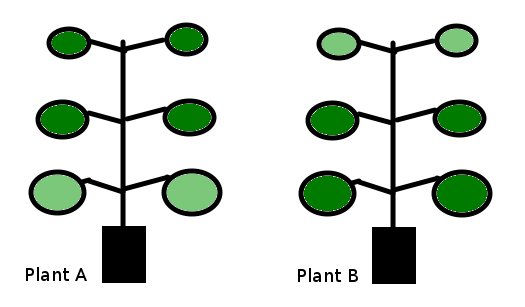How to tell which nutrient a plant needs by understanding and observing nutrient mobility in tomato plants.
Nutrient Mobility and Tomato Plants
Some nutrients are considered mobile and some immobile.
Nitrogen, for example, moves around a plant’s system quickly – because nitrogen is mobile. Calcium on the other hand, is immobile and does not move from one part of a plant to another, once it gets into a plants system it stays in that area.
For example:
- Mobile nutrients: Nitrogen and Magnesium
- Immoblie nutrients: Calcium; Iron (semi-mobile)
Top Leaves
If top leaves need more nitrogen than is being supplied by the roots, the top leaves will take the extra nitrogen they need from the lower leaves. This is sometimes referred to as translocation.
Lower leaves
So if the lower leaves are turning pale and look as if they are in need of a good feed (plant A below), it is probably because the top growth has taken their nitrogen!
Magnesium is also mobile and is regularly moved from the lower to the upper leaves if required.
However, when top leaves are pale and lower leaves are ok (plant B below), it cannot be a nitrogen or magnesium shortage. If it were, the top leaves would have removed the nitrogen and/or magnesium from the lower leaves.

So, when top leaves are pale (plant B), it is most likely an immobile nutrient that is deficient.
Calcium is immobile and that is why we have so much Blossom End Rot in fruit. A slight shortage of Calcium when the tomatoes are forming will cause Blossom End Rot (BER).
Calcium deficiency also shows as stunted new growth at the growing tip.
To a lesser extent iron (semi-mobile) will also show as a deficiency in the top leaves. Pale yellow/green leaves around the growing tip is likely to be an iron shortage.
Interruption
Every time nutrient intake (and moisture) through the roots slows or stops, means that the flow of immobile nutrients such as calcium and iron are interrupted and a deficiency is likely to occur.
This is one very good reason why having nutrients available 24/7, by way of water reservoirs etc., is the better way to grow tomatoes. See Self Watering Planters.
It doesn’t matter how much calcium there is in the soil, if the soil runs dry, the intake of calcium through the roots will be interrupted, the plant will be unable to move calcium from one part of the plant to another and Blossom End Rot is likely to occur.
Temperatures, nutrient balance in the soil and pH also play their role in nutrient mobility in tomato plants. However, if a plant starts off healthy then shows leaf symptoms as described above, it can be quickly diagnosed and a foliar spray applied.
A foliar spray is an excellent way to feed supplement nutrients, as there won’t be an issue over having too much of one nutrient in the soil and possible nutrient blocking.

